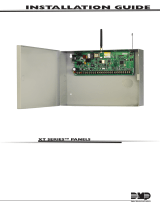
Installation and Programming Manual
2-2
W
W
i
i
r
r
i
i
n
n
g
g
t
t
h
h
e
e
M
M
a
a
i
i
n
n
B
B
o
o
a
a
r
r
d
d
(see Figures 2-4, 2-6, 2-7 on pages 2-10, 2-11 and 2-12)
CONNECTION COMMENTS
Expansion BUS
and
Keypad Connections
AUX (Red) COM (Blk)
BUS (Yel) BUS (Grn)
the first four terminals at the left of the Main Board represent the system’s
Expansion BUS, supporting the connection of keypad(s) and Expansion
Modules
use a quality 4-conductor cable with an adequate gauge size (e.g. 22-18,
see page 2-7) to accommodate any voltage drops which may occur when
multiple keypads and long wire runs are employed (also see Figure 2-6 on
page 2-11); for convenience, you may wish to match the wire colors to the
BUS connections
additional branches of the Expansion BUS may be derived from any other
point on the BUS (see Figure 2-6, page 2-11)
the maximum wire run permitted is 1000 feet for all legs of the BUS (see
page 2-8)
Zone Wiring to
Sensors and Detectors
Zone Terminals
(Z1 through Z8)
connect the wiring for up to 8 hardwired zones using the wiring of
your choice (e.g. twisted pair, 4-conductor cable)
each zone must be wired to the appropriate zone (Z) terminal and the
adjacent common (COM) connection; for example, wire Zone 1 to the Z1
and COM terminals; wire Zone 2 to Z2 and the same (COM) terminal (see
Figure 2-4, page 2-10, and Figure 2-7, page 2-12)
for supervision against short circuits, it's recommended (but not required)
that you use a 2200Ω End-of-Line Resistor (16 are supplied) at the far end
of each hardwired zone
unused zones must be terminated at the control panel according to how
the zone is configured in the Installer Programming section of this manual
(on page 3-10)
for intrusion detectors requiring power (e.g. PIRs, photoelectric systems,
certain shock sensors, audio switches), you may want to incorporate the
zone wiring and the power wiring in the same cable; if so, be sure you
choose a wire gauge (e.g. 22-16) which takes into account the number of
detectors and the amount of wire required
only 4-wire Smoke Detectors can be used with the Pro-24; 2-wire Smoke
Detectors are not supported
for proper 4-wire Smoke Detector supervision, a Power Supervision Relay
is required. Wire the relay according to the layout in Figure 2-7, (on page
2-12); by doing so, the loss of power to the detector(s) will de-energize the
relay, cause a break in the zone wiring, and a subsequent “Fire Trouble”
indication generated at the panel
Power to Auxiliary Devices:
Continuous Auxiliary Power
AUX COM
(+) (–)
wire these terminals to power PIRs, glass-break detectors (4-wire types),
audio switches, photoelectric systems, and any device whose operation
requires a continuous supply of 12 Volts DC
do NOT use these terminals to supply power to Smoke Detectors; they
must be powered by the Switched Auxiliary Power (see below)
wire should be of a suitable gauge (e.g. 22-16) to accommodate
any voltage drop which might occur based on current requirements and
distances involved
when many auxiliary devices are employed in an installation, consider the
use of the optional Power Supply Expansion Module
, previously discussed,
and covered on page 2-6)
Power to 4-Wire
Smoke Detectors
Switched (Interruptible)
Auxiliary Power
S.AUX COM
(+) (–)
wire these terminals to power Smoke Detectors (4-wire types, ONLY) and
any device whose operation requires resetting after an alarm condition
(see Figure 2-7 on page 2-12)
do NOT use these terminals to supply power to devices requiring
continuous power, like PIRs, audio switches, 4-wire glass break detectors,
photo-electric systems, etc.; you must use the continuous (non-
interruptible) supply, discussed above
observe the wiring guidelines mentioned in the previous section, along
with any applicable local requirements applicable to Smoke Detectors




















